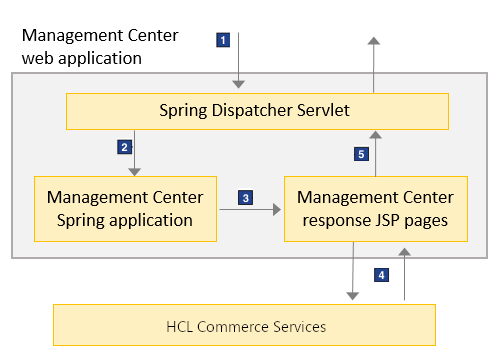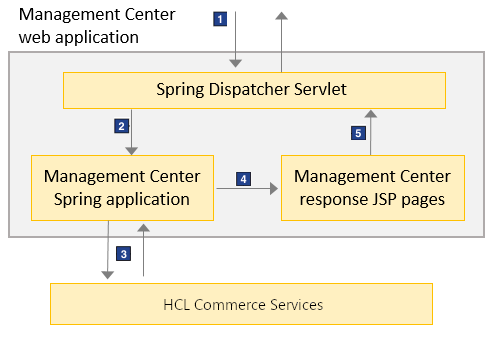Management Center web application
The Management Center web application is a Spring web application that facilitates communication between Management Center and HCL Commerce services.
Management Center sends URL requests and receives XML responses, while the HCL Commerce server uses BOD messages to retrieve nouns and invoke business logic. The Management Center web application acts as a mediator between Management Center and HCL Commerce services by converting requests and responses into the appropriate type of data. Specifically, the Management Center web application provides Spring bean definitions that define controllers and view resolvers to complete the following tasks:
- Send data from Management Center to HCL Commerce by converting URL requests into BOD messages
- Return data toManagement Center from HCL Commerce by converting BOD messages into an XML response that Management Center understands
- Categories
- Products
- Promotions
- Marketing activities
The Management Center web application contains a business context filter to include default
business context information in all service requests. The purpose of this filter is to create a
business context object and place it within a request. The business context object that is created
by the filter is the standard business context parameters that are included in any service request.
The filter has a parameter that is called businessContext.intent, which represents
the intent of the business context. This attribute is set by the web application. Do not change the
attribute by using a URL parameter. The purpose of this configuration parameter is to declare the
intent of the service request to ensure the proper processing environment.
The flow of an URL request from Management Center to the HCL Commerce server differs slightly when an operation is retrieving business objects (get) and when an operation is processing business objects (create or write).
Retrieving business objects
The Management Center web application uses two types of JSP pages to retrieve business objects: get controller JSP pages and serialization JSP fragments. These JSP pages facilitate the mediation between the Management Center web application and HCL Commerce services. These JSP pages are not intended to display data to shoppers, for example, through the store front.
- Get controller JSP pages
- When Management Center retrieves business objects from the HCL Commerce server,
get controller JSP pages are invoked. The get controller JSP page invokes the
get-datatag library to retrieve the noun that is used for the business object. The serialization JSP fragments converts the noun into the XML representation that is expected by Management Center.
- Serialization JSP fragments
- When an operation is returning a response, serialization JSP fragments transform the noun into the appropriate XML representation that is expected by Management Center. These JSP fragments are included by the get controller JSP pages.

The lifecycle of an URL request to retrieve business objects:
- Management Center issues an URL request. The URL request enters the identity token servlet filter to resolve the authentication information for the request.
- The spring dispatcher servlet resolves the request to the Spring bean definition property that identifies the get controller JSP page.
- The Spring framework immediately forwards the request to the defined get controller JSP page.
- The get controller JSP page uses the
get-datatag to construct and invoke the appropriateGetservice. This service retrieves the list of nouns that matches the expression, and then calls the appropriate serialization JSP fragment. - The serialization JSP fragment formats the nouns into the XML format that is expected by Management Center. This XML is the response of the URL request.
Processing and changing business objects
The process service and change service are services that correspond to process requests and change BOD requests. These services are represented by a Spring bean definition that defines the controller and view resolver classes for building and sending the request. Once the request is issued, the JSP file communicates the result of the request to Management Center.

The lifecycle of a URL request to process and change business objects:
- Management Center issues an URL request. The URL request enters the identity token servlet filter to resolve the authentication information for the request.
- The Spring framework controller builds the appropriate
changeorprocessrequest that matches the specific URI invoked. - The client library is used to issue the BOD request and receive the BOD response.
- The BOD response is parsed into a flattened
java.util.Map. Thejava.util.Mapand nouns in the response are forwarded to the Spring view resolver. Based on the result of the BOD request, the resulting JSP page for the view is either for a success, failure, or error response. - The appropriate JSP page creates the response for the request. This response contains the information that is related to the result of the request, including any changed information that Management Center requires as a result of the request.